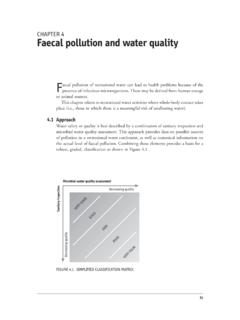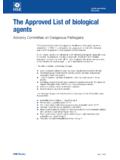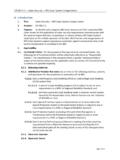Transcription of Microbiological Guidelines
1 Microbiological Guidelines for Ready-to-eat Food May 2007 (revised) Centre for Food Safety This set of Guidelines is published by The Centre for Food Safety, Food and Environmental Hygiene Department. The technical content has been developed in consultation with the Expert Panel on Microbiological Safety of Food of the Food and Environmental Hygiene Department. Correspondence: Risk Assessment Section Centre for Food Safety Food and Environmental Hygiene Department 43/F, Queensway Government Offices, 66 Queensway, Hong Kong. Tel: (852)28675699 Fax: (852)28933547 Email: Microbiological Guidelines for Ready-to-eat Food Preface According to the Codex Alimentarius Commission, an international food standard setting authority, the functions of Microbiological Guidelines include formulation of design requirements, indication of required and expected Microbiological status of the food commodities, and the verification of efficacy of hygienic practice.
2 In 2002, under the advice of the Expert Panel on Microbiological Safety of Food, an expert group set up to advise the Director of Food and Environmental Hygiene, a set of Microbiological Guidelines for ready-to-eat food has been developed by the Food and Environmental Hygiene Department. These Guidelines stipulate the safety limits of nine major food borne pathogens such as Salmonella species, Listeria monocytogenes, E. coli O157 and Vibrio cholerae, as well as providing a classification of Microbiological quality of ready-to-eat food for reflecting the hygienic status of the food concerned. In light of changing needs and latest expert views, the Guidelines were revised in 2007. The revision mainly includes textural amendment of the Guidelines and revising the Microbiological limits for Listeria monocytogenes, making reference to international practices.
3 With the Microbiological limits explicitly set, it serves to facilitate the trade in devising measures to improve their food safety practices and to assist officers in monitoring and control of food safety. Based on the specified limits and classification of respective ready-to-eat food items as provided in the Guidelines , the food trade can draw up relevant food control plans and focus on the priority control measures. The trade is an important partner in enhancing food safety. With better knowledge on Microbiological safety of ready-to-eat food, the standards of their practices can be further improved. We hope this set of Guidelines serves their needs in this area. Centre for Food Safety Food and Environmental Hygiene Department May 2007 - i - Expert Panel on Microbiological Safety of Food Terms of Reference (a) To review and recommend to the Director of Food and Environmental Hygiene the Microbiological criteria for the assessment of food safety; (b) To advise on strategies of the food surveillance programme in respect of Microbiological safety of food; (c) To evaluate the scientific evidence, both international and local, which are relevant to the development of Microbiological standards and Guidelines on food; and (d) To propose priority issues in risk assessment in respect of Microbiological hazards of food.
4 Membership The Panel comprises official members from the Food and Environmental Hygiene Department and non-official members appointed by the Director of Food and Environmental Hygiene. The Panel is chaired by Consultant (Community Medicine) (Risk Assessment and Communication) with Secretariat support provided by Risk Assessment Section of the Centre for Food Safety. The non-official members for the terms 2002 to 2007 are: Professor IP Margaret Professor, Department of Microbiology, The Chinese University of Hong Kong Dr KAM Kai Man Consultant Medical Microbiologist, Public Health Laboratory Services Branch, Centre for Health Protection, Department of Health Dr NG Tak Keung Consultant Microbiologist, Department of Pathology, Princess Margaret Hospital Professor YUEN Kwok Yung Chair Professor in Infectious Disease.
5 University of Hong Kong - ii - Microbiological Guidelines for Ready-to-eat Food - Recommendations for Food Safety Monitoring in Hong Kong- Food safety control aims to safeguard public health and provide assurance on food safety. To this end, Microbiological analyses are useful ways to assess the safety and quality of food involved. This paper presents the recommended Microbiological Guidelines for ready-to-eat food. Purpose of the Guidelines 2. In the Hong Kong Special Administrative Region, the legal powers and instruments for the enforcement of Microbiological safety of food are provided for in the Public Health and Municipal Services Ordinance (PHMSO), Chapter 132. Section 54 stipulates that it is an offence to sell food that is unfit for human consumption.
6 General protection for purchasers of food is provided in Section 52 of the Ordinance when the food is not of the nature, substance, quality of the food demanded by the purchaser. Legal Microbiological standards for some specified foods are stipulated in the legislation. 3. Microbiological Guidelines are criteria indicating the Microbiological condition of the food concerned so as to reflect its safety and hygienic quality. The purpose of this set of Microbiological Guidelines is to provide assistance to officers in the interpretation of Microbiological analyses of ready-to-eat food and recommendations on the appropriate follow-up action for food safety monitoring and control. It also serves to facilitate the trade in devising measures to improve their food safety practices.
7 Definition and Interpretation 4. Ready-to-eat is defined as the status of the food being ready for immediate consumption at the point of sale. It could be raw or cooked, hot or chilled, and can be consumed without further heat-treatment including re-heating. 5. Aerobic colony count (ACC) is a count of viable bacteria based on counting of colonies grown in nutrient agar plate. This is commonly employed to indicate the sanitary quality of foods. The incubation condition of ACC used in this guideline is 30o C for 48 hours. - 1 - 6. Indicator organism refers to the selected surrogate markers. The main objective of using bacteria as indicators is to reflect the hygienic quality of food. E. coli is commonly used as surrogate indicator.
8 Its presence in food generally indicates direct or indirect faecal contamination. Substantial number of E. coli in food suggests a general lack of cleanliness in handling and improper storage. 7. Specific pathogens refer to bacteria that may cause food poisoning. Mechanisms involved may be toxins produced in food or intestinal infection. The symptoms of food poisoning vary from nausea and vomiting ( caused by S. aureus), through diarrhoea and dehydration (Salmonella spp. and Campylobacter spp.) to paralysis and death in the rare cases of botulism. The infectious doses vary from less than 10 to more than 106 organisms. Components of Microbiological Criteria 8. The Microbiological limits of this set of Guidelines are organised under the following three components: (a) Aerobic Colony Count; (b) Indicator Organism E.
9 Coli count is the only indicator organism included; and (c) Specific Food Poisoning Pathogens nine specific bacterial pathogens are included in this set of Guidelines . 9. For assessment of hygienic quality, food items are grouped into five categories taking into account the raw ingredients used, and the nature and degree of processing before sale. The categorisation is summarised in the Food category table for ACC assessment in Annex I. - 2 - - 3 - Classification of Microbiological Quality 10. The Microbiological assessment of ready-to-eat food on the above three components will lead to the classification of the food quality into one of the following four classes: (a) Class A: the Microbiological status of the food sample is satisfactory.
10 (b) Class B: the Microbiological status of the food sample is less than satisfactory but still acceptable for consumption. (c) Class C: the Microbiological status of the food sample is unsatisfactory. This may indicate a sub-optimal hygienic conditions and Microbiological safety levels. Licensees of food premises should be advised to investigate and find out the causes and to adopt measures to improve the hygienic conditions. Taking of follow-up samples to verify the improvement may be required. (d) Class D: the Microbiological status of the food sample is unacceptable. The food sample contains unacceptable levels of specific pathogens that is potentially hazardous to the consumer. In addition to giving advice to the licensee of the food premises as stated in (c) above, warning letters as well as other enforcement actions should be considered.





